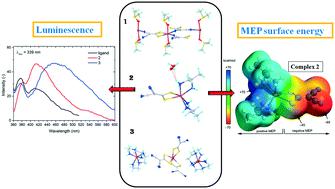当前位置:
X-MOL 学术
›
CrystEngComm
›
论文详情
Our official English website, www.x-mol.net, welcomes your feedback! (Note: you will need to create a separate account there.)
On the supramolecular properties of neutral, anionic and cationic cadmium complexes harvested from dithiolate–polyamine binary ligand systems
CrystEngComm ( IF 3.1 ) Pub Date : 2020-10-22 , DOI: 10.1039/d0ce01233e Suman Adhikari 1, 2, 3, 4 , Tirtha Bhattacharjee 1, 4, 5, 6 , Arijit Das 1, 4, 7, 8 , Subhadip Roy 1, 4, 9, 10 , Constantin Gabriel Daniliuc 11, 12, 13, 14 , Jan K. Zaręba 15, 16, 17, 18 , Antonio Bauzá 19, 20, 21, 22 , Antonio Frontera 19, 20, 21, 22
CrystEngComm ( IF 3.1 ) Pub Date : 2020-10-22 , DOI: 10.1039/d0ce01233e Suman Adhikari 1, 2, 3, 4 , Tirtha Bhattacharjee 1, 4, 5, 6 , Arijit Das 1, 4, 7, 8 , Subhadip Roy 1, 4, 9, 10 , Constantin Gabriel Daniliuc 11, 12, 13, 14 , Jan K. Zaręba 15, 16, 17, 18 , Antonio Bauzá 19, 20, 21, 22 , Antonio Frontera 19, 20, 21, 22
Affiliation

|
Three Cd(II) complexes [Cd(i-mnt)(DMSO)2]n (1), {[Cd(i-mnt)pn]·2H2O} (2), and [Cd(i-mnt)3][Cd(tren)2]2 (3) harvested from 1,1-dicyanoethylene-2,2-dithiolate (i-mnt2−) and polyamine ligand systems have been designed, synthesized and structurally characterized. Single-crystal X-ray diffraction analysis reveals that these complexes exhibit diverse supramolecular architectures primarily thanks to different coordination modes adopted by (i-mnt2−) and polyamine ligands, and also owing to their disparate conformational flexibility. Indeed, polyamines (pn = 1,2-diamino propane, tren = diethylenetriamine) and (i-mnt2−) ligands demonstrate the impact of the directing effect of the ligands' spatial extension, binding abilities and flexibility on the resulting structures of the complexes. Complex 1 is a 2D coordination polymer, whereas discrete complex 2 involves a cadmium center with a distorted octahedral geometry and forms a hydrogen bonding network of an unprecedented topological type ({411698}{4462} point symbol notation). Complex 3 is a cocrystalline aggregate of one anionic [Cd(i-mnt)3]4− unit flanked by two cationic [Cd(tren)2]2+ units. DFT calculations (M06-2X/def2-TZVP level of theory) were performed in order to quantify the energetic contributions of non-covalent interactions. In 2, the energetics of hydrogen bonding interactions is explored while in the case of 3 unidirectional electrostatic interactions between the counterions are studied. Analyses of Hirshfeld surfaces (HSs) and of two-dimensional fingerprint plots provided another means of quantification of intermolecular contacts experienced by the neutral, cationic, and anionic cadmium complexes. It is found that the calculated contact contributions to the HS of neutral complex 2 are similar to the HS properties of cationic complexes in 3, i.e. being dominated predominantly by H⋯H and S⋯H contacts, despite significant differences in their structures. Moreover, the steady-state luminescence properties of dimethylsulfoxide solutions of the ligand (i-mnt2−) and of complexes 1–3 are also examined.
中文翻译:

从二硫醇盐-多胺二元配体系统中收集的中性,阴离子和阳离子镉络合物的超分子性质
三种Cd(II)络合物[Cd(i-mnt)(DMSO)2 ] n(1),{[Cd(i-mnt)pn]·2H 2 O}(2)和[Cd(i-mnt)从1,1-二氰亚乙基-2,2-二硫代酸酯(i-mnt 2-)和多胺配体系统中收获的3 ] [Cd(tren)2 ] 2(3)和聚胺配体系统已被设计,合成和结构表征。单晶X射线衍射分析表明,这些络合物表现出多种超分子结构,这主要归功于(i-mnt 2-)和多胺配体,以及由于它们不同的构象柔韧性。实际上,多胺(pn = 1,2-二氨基丙烷,tren =二亚乙基三胺)和(i-mnt 2-)配体证明了配体的空间扩展,结合能力和柔韧性对所得结构的指导作用的影响。复合体。配合物1是2D配位聚合物,而离散配合物2包含具有扭曲的八面体几何形状的镉中心,并形成了前所未有的拓扑类型的氢键网络({4 11 6 9 8} {4 4 6 2 }点符号表示法) 。复杂3是一个阴离子[Cd(i-mnt)3 ] 4-单元的侧翼,两个阳离子[Cd(tren)2 ] 2+单元的共结晶聚集体。为了定量非共价相互作用的能量贡献,进行了DFT计算(M06-2X / def2-TZVP理论水平)。在2中,探索了氢键相互作用的能量,而在3中,研究了抗衡离子之间的单向静电相互作用。Hirshfeld表面(HSs)和二维指纹图的分析提供了定量中性,阳离子和阴离子镉络合物经历的分子间接触的另一种方法。发现计算得出的对中性配合物2的HS的接触贡献与3中阳离子配合物的HS特性相似,即尽管结构显着不同,但主要由H⋯H和S theirH接触支配。此外,还研究了配体(i-mnt 2-)和配合物1-3的二甲基亚砜溶液的稳态发光特性。
更新日期:2020-11-12
中文翻译:

从二硫醇盐-多胺二元配体系统中收集的中性,阴离子和阳离子镉络合物的超分子性质
三种Cd(II)络合物[Cd(i-mnt)(DMSO)2 ] n(1),{[Cd(i-mnt)pn]·2H 2 O}(2)和[Cd(i-mnt)从1,1-二氰亚乙基-2,2-二硫代酸酯(i-mnt 2-)和多胺配体系统中收获的3 ] [Cd(tren)2 ] 2(3)和聚胺配体系统已被设计,合成和结构表征。单晶X射线衍射分析表明,这些络合物表现出多种超分子结构,这主要归功于(i-mnt 2-)和多胺配体,以及由于它们不同的构象柔韧性。实际上,多胺(pn = 1,2-二氨基丙烷,tren =二亚乙基三胺)和(i-mnt 2-)配体证明了配体的空间扩展,结合能力和柔韧性对所得结构的指导作用的影响。复合体。配合物1是2D配位聚合物,而离散配合物2包含具有扭曲的八面体几何形状的镉中心,并形成了前所未有的拓扑类型的氢键网络({4 11 6 9 8} {4 4 6 2 }点符号表示法) 。复杂3是一个阴离子[Cd(i-mnt)3 ] 4-单元的侧翼,两个阳离子[Cd(tren)2 ] 2+单元的共结晶聚集体。为了定量非共价相互作用的能量贡献,进行了DFT计算(M06-2X / def2-TZVP理论水平)。在2中,探索了氢键相互作用的能量,而在3中,研究了抗衡离子之间的单向静电相互作用。Hirshfeld表面(HSs)和二维指纹图的分析提供了定量中性,阳离子和阴离子镉络合物经历的分子间接触的另一种方法。发现计算得出的对中性配合物2的HS的接触贡献与3中阳离子配合物的HS特性相似,即尽管结构显着不同,但主要由H⋯H和S theirH接触支配。此外,还研究了配体(i-mnt 2-)和配合物1-3的二甲基亚砜溶液的稳态发光特性。



























 京公网安备 11010802027423号
京公网安备 11010802027423号